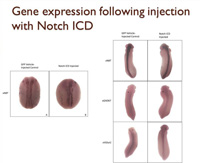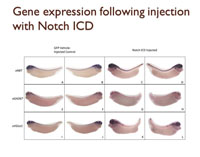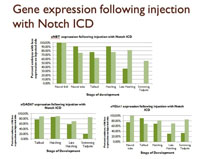Molly McDonough '12 Presents Research Results at Neuroscience Symposium
 When Molly McDonough ’12 presented her research at William and Mary’s annual Neuroscience Symposium in November, the opportunity was both an honor and a celebration of why she came to the College.
When Molly McDonough ’12 presented her research at William and Mary’s annual Neuroscience Symposium in November, the opportunity was both an honor and a celebration of why she came to the College.
“I chose to come to William and Mary specifically because I knew there was an opportunity to do research here,” says Molly, a Biology major. “I definitely don’t think I would have gotten this level of opportunity somewhere else.”
Molly began working in biology professor Margaret Saha’s lab the spring semester of her freshman year, with support from a Howard Hughes Medical Institute grant. Her symposium presentation focused on a nervous system research project Molly has worked on for six semesters and two summers in Saha’s lab.
“There aren’t many graduate students in neuroscience here, so undergrads get to do a lot of the research – graduate-level research,” says Molly. “With the help and advice of Prof. Saha, I've learned how to design an experiment, hypothesize, theorize, and really think like a scientist.”
Dr. Saha's lab studies how a body’s billions of neurons communicate through chemicals called neurotransmitters. Specifically, they want to uncover how each neuron comes to have a specific neurotransmitter phenotype during development. In other words, how does a neuron know what chemical signal to secrete?
 Molly’s approach to this question focuses on a cell-signaling pathway called Notch signaling (the molecular mechanism responsible for regulating signaling between neighboring cells) in African clawed frogs. Immediately after the frog embryos were born, Molly injected them with RNA constructs that either over-express or inhibit portions of the Notch pathway. She allowed the embryos to grow to different stages of development and then examined the expression of three genes: a pan-neural marker, a marker of excitatory neurons, and a marker of inhibitory neurons.
Molly’s approach to this question focuses on a cell-signaling pathway called Notch signaling (the molecular mechanism responsible for regulating signaling between neighboring cells) in African clawed frogs. Immediately after the frog embryos were born, Molly injected them with RNA constructs that either over-express or inhibit portions of the Notch pathway. She allowed the embryos to grow to different stages of development and then examined the expression of three genes: a pan-neural marker, a marker of excitatory neurons, and a marker of inhibitory neurons.
“I found that my injections did not alter the ratio of excitatory or inhibitory phenotypes. Instead, we saw huge alterations in the number of neurons present at early stages of nervous system formation,” says Molly. “As the brain and spinal cord developed further, these alterations fade until they are ultimately not detectable. This implies that the embryos are somehow compensating in response to the early alterations.”
somehow compensating in response to the early alterations.”
Through additional research, Molly hopes to explain how this is happening and how the results may vary when these perturbations are activated at later stages in development.
 “Notch signaling is also a pathway involved in human brain development,” says Molly, who is working on an Honors thesis and hopes to publish a paper on her research. “As such, expanding our understanding of how this pathway interacts with other molecular mechanisms in the brain is important.”
“Notch signaling is also a pathway involved in human brain development,” says Molly, who is working on an Honors thesis and hopes to publish a paper on her research. “As such, expanding our understanding of how this pathway interacts with other molecular mechanisms in the brain is important.”
In addition to presenting her results at the College’s Neuroscience symposium, Molly also had the opportunity to present a poster of her work at the annual Society for Neuroscience meeting in Washington, D.C., in mid-November.
“Through this experience, I’ve received encouraging and supportive feedback from other scientists in this field,” says Molly. “The opportunity that I have had to conduct this research has been crucial to my growth as a student and a scientist. I feel very prepared for my future work in graduate school.” Skip to main content
Skip to main content
